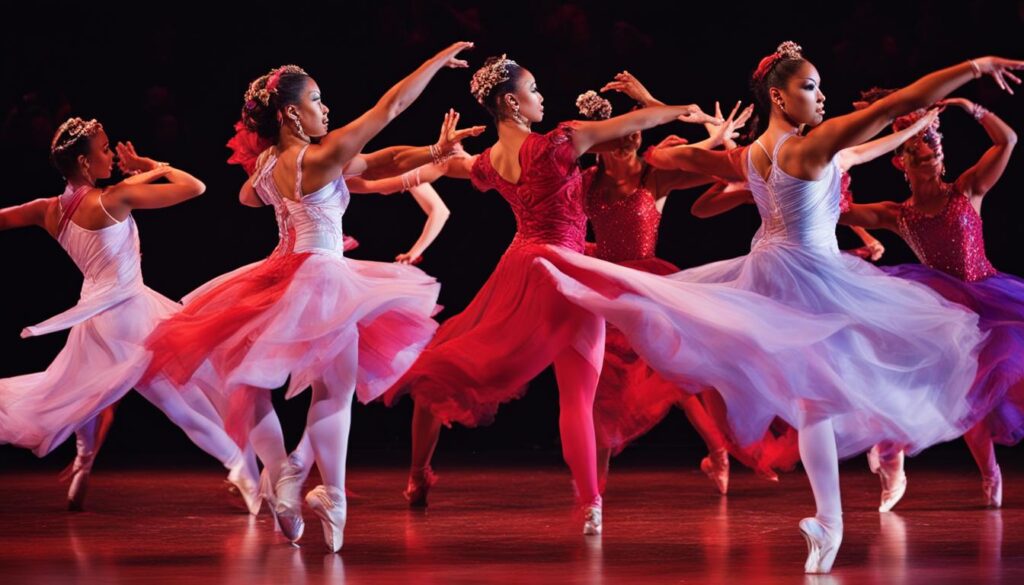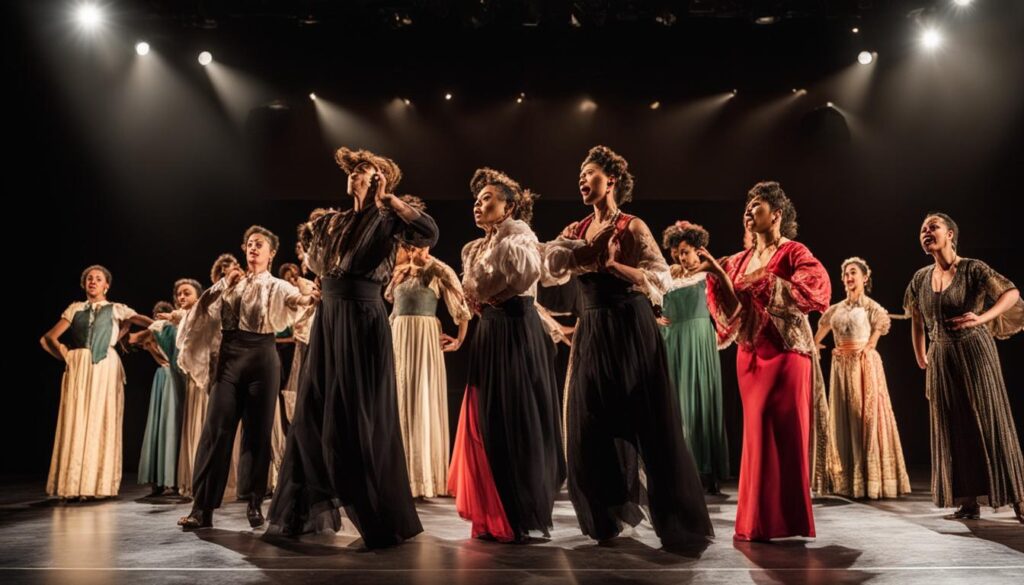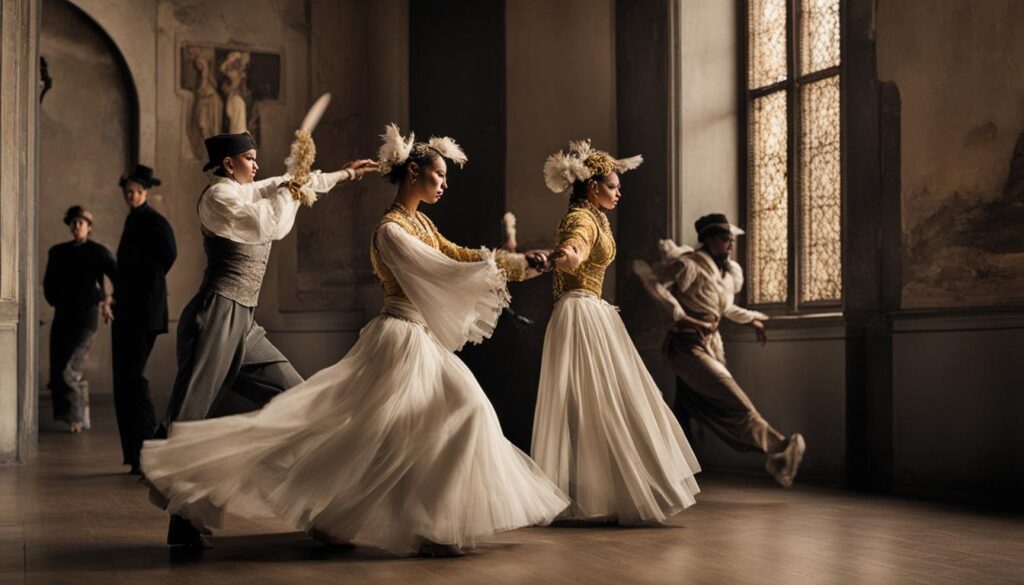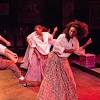Performing arts encompass a wide range of disciplines that have been an integral part of human culture since ancient times. From music to dance to theatre, performing arts provide entertainment, expression, and reflection for both performers and audiences. In this article, I will delve into the examples of performing arts, highlighting the various disciplines and genres that make up this vibrant and dynamic form of artistic expression.
Key Takeaways:
- Performing arts include disciplines such as music, dance, and theatre.
- Examples of performing arts disciplines range from acrobatics to puppetry to stand-up comedy.
- Performing arts have a rich history and are present in all human cultures.
- Performance art provides a platform for artists to express their emotions and ideas in unconventional ways.
- Engaging with performing arts allows us to connect with our emotions and appreciate the power of artistic expression.
Types of Performing Arts
Performing arts encompass a wide range of disciplines and genres that contribute to the diverse world of artistic expression. From traditional theater and classical music to avant-garde performance art, each form of performing art offers its own unique experience. Here are some of the main types of performing arts:
Theater
Theater is a fundamental form of performing art that combines acting, storytelling, and stagecraft. It includes various genres such as drama, comedy, musicals, and experimental theater. Theater performances often take place in dedicated venues like playhouses or theaters and involve a cast of actors who bring characters to life on stage.
Dance
Dance is a captivating art form that uses precise movements, gestures, and expressions to convey emotions and tell stories. It encompasses a wide range of styles, including ballet, contemporary, hip-hop, and traditional cultural dances. Dancers use their bodies as a medium of expression, combining technique, rhythm, and creativity to captivate audiences.
Music
Music as a performing art involves creating and performing melodies, harmonies, and rhythms using instruments, voices, or a combination of both. It includes genres like classical, jazz, rock, pop, and world music. Musicians showcase their skill and artistry through performances that can range from solo recitals to large-scale concerts.
Opera
Opera is a unique form of performing art that combines singing, acting, and orchestral music. It tells stories through a synthesis of music, words, and visual elements. Operas are typically performed in opera houses and feature trained opera singers who convey emotions and narratives through their powerful voices.
These are just a few examples of the diverse types of performing arts. Each discipline brings its own style, techniques, and artistic vision to the stage, captivating audiences and creating memorable experiences.


The Impact of Performance Art
Performance art is a powerful and impactful form of artistic expression that engages both artists and audiences on multiple levels. It goes beyond traditional art forms by encompassing a wide range of activities that involve the body, space, and time. Performers use their bodies as a tool to convey emotions, ideas, and narratives, creating a unique and immersive experience for viewers.
One of the key aspects of performance art is its ability to challenge societal norms and push boundaries. Artists use this medium to explore unconventional ideas, provoke thought, and question established beliefs. Performance art encourages dialogue and reflection, inviting viewers to actively engage with the performance and interpret its meaning. This interactive nature allows for a deeper connection between the artist and the audience, generating a dynamic exchange of emotions and ideas.
Performance art is not just a form of entertainment; it is a means of expression that can address social, cultural, and political issues. It has the potential to raise awareness, ignite conversations, and create change.
Through performance art, artists are able to express their innermost thoughts, feelings, and experiences in a raw and authentic way. It offers them a platform to communicate their unique perspectives and challenge conventional modes of expression. By breaking free from the confines of traditional art forms, performance artists can experiment, innovate, and create experiences that are both visually and intellectually stimulating.
In essence, performance art is a catalyst for self-expression and cultural exploration. It encourages artists to step outside their comfort zones and invites audiences to actively participate in the creative process. By embracing the fluidity and immediacy of performance, we can gain a deeper understanding of ourselves, each other, and the world around us.


Performing Arts Activities:
| Activity | Description |
|---|---|
| Dance | A rhythmic movement of the body to express emotions and tell stories. |
| Theatre | Live performances that involve acting, storytelling, and stagecraft. |
| Music | Creating and performing sounds and melodies using instruments or vocals. |
| Circus Skills | Acrobatics, juggling, and other physical feats performed in a circus setting. |
| Mime | A form of silent performance that uses gestures and facial expressions to tell stories. |
| Stand-up Comedy | Performing comedic routines and jokes in front of an audience. |
The performing arts encompass a wide range of activities and expressions that have the power to entertain, inspire, and provoke thought. Whether it’s through dance, theatre, music, or other forms, performance art continues to evolve and shape our understanding of the human experience.
Historical Significance of Performance Art
Performance art has a fascinating history that dates back to ancient times. In the Western world, the roots of performance art can be traced back to ancient Greece, where tragic poets like Sophocles incorporated dance into their theatrical performances. This fusion of poetry and movement laid the foundation for what would later become a diverse and influential art form.
During the Renaissance period, Italy witnessed a revival of performing arts, with the emergence of opera and the development of new theatrical techniques. This artistic movement then spread throughout Europe, paving the way for the growth and evolution of performance art in various forms.
“Performance art is not about telling a story or entertaining the audience; it’s about challenging conventions, exploring new ideas, and making a statement.”
In more recent times, performance art has embraced experimentation and innovation. Artists have pushed the boundaries of traditional artistic mediums, incorporating elements of technology, multimedia, and interactive experiences. Performance art has become a platform for artists to explore and express their creativity, often tackling important social, cultural, and political issues.
The Evolution of Performance Art
Throughout history, performance art has undergone significant transformations and has been influenced by various movements and styles. From the avant-garde experiments of the Dadaists in the early 20th century to the bold and provocative actions of the Fluxus movement in the 1960s, performance art has continuously challenged audiences and pushed the boundaries of artistic expression.
Today, performance art continues to evolve and adapt to the ever-changing cultural landscape. Artists from different backgrounds, cultures, and disciplines are embracing performance art as a means of connecting with audiences on a deeper, more visceral level. It remains an integral part of the contemporary art scene, offering a unique and thought-provoking experience for both performers and spectators alike.


| Historical Period | Key Developments |
|---|---|
| Ancient Greece |
|
| Renaissance |
|
| Modern Times |
|
Conclusion
Performing arts encompass a wide range of disciplines and genres, from theatre and dance to music and performance art. They have been an integral part of human culture since ancient times, providing entertainment, expression, and reflection. Examples of performing arts include acrobatics, ballet, circus skills, dance, music, opera, puppetry, speech, stand-up comedy, street performance, and theatre, among others. These disciplines have a rich history and are present in all human cultures, allowing for diverse forms of artistic expression.
Performance art, in particular, pushes the boundaries of traditional artistic mediums and offers a unique and thought-provoking experience. It allows artists to express their emotions and ideas in unconventional ways, challenging societal norms and encouraging dialogue and reflection. The impact of performance art extends to both artists and audiences, creating a dynamic and interactive experience where audience members actively engage with the performance.
Throughout history, performance art has played a significant role in shaping and exploring human creativity. From ancient Greece to the Renaissance and beyond, performance art has evolved and diversified, reflecting the changing times and artistic movements. It has become a powerful medium for social, cultural, and political expression, raising awareness and sparking meaningful conversations in society.
Engaging with performing arts, whether as performers or audience members, allows us to connect with our emotions, explore new perspectives, and appreciate the power of artistic expression. The examples of performing arts discussed in this article demonstrate the vast range of disciplines and genres that contribute to the rich tapestry of human culture and creativity.
FAQ
What are some examples of performing arts?
Examples of performing arts include acrobatics, ballet, circus skills, dance, gymnastics, magic, mime, music, opera, puppetry, speech, stand-up comedy, street performance, theatre, and ventriloquism.
What types of performing arts are there?
Performing arts encompass a variety of disciplines and genres, including acrobatics, ballet, circus skills, dance, gymnastics, magic, mime, music, opera, puppetry, speech, stand-up comedy, street performance, theatre, and ventriloquism.
How does performance art impact artists and audiences?
Performance art provides a unique platform for artists to express their emotions and ideas in unconventional ways. It pushes boundaries, challenges societal norms, and encourages experimentation. For audiences, performance art offers a dynamic and interactive experience, allowing them to actively engage and reflect on the performance.
What is the historical significance of performance art?
Performance art has a rich history dating back to ancient times. In the Western world, it began in ancient Greece with tragic poets incorporating dance into their plays. During the Renaissance, performing arts experienced a revival in Italy and spread throughout Europe. Performance art has since evolved and diversified, becoming a key medium for artists to explore and express their creativity.
How do performing arts impact society and culture?
Performing arts have been an integral part of human culture since ancient times. They provide entertainment, expression, and reflection, allowing us to connect with our emotions and explore new perspectives. Performance art, in particular, can be a powerful tool for social, cultural, and political expression, raising awareness and sparking meaningful conversations.

